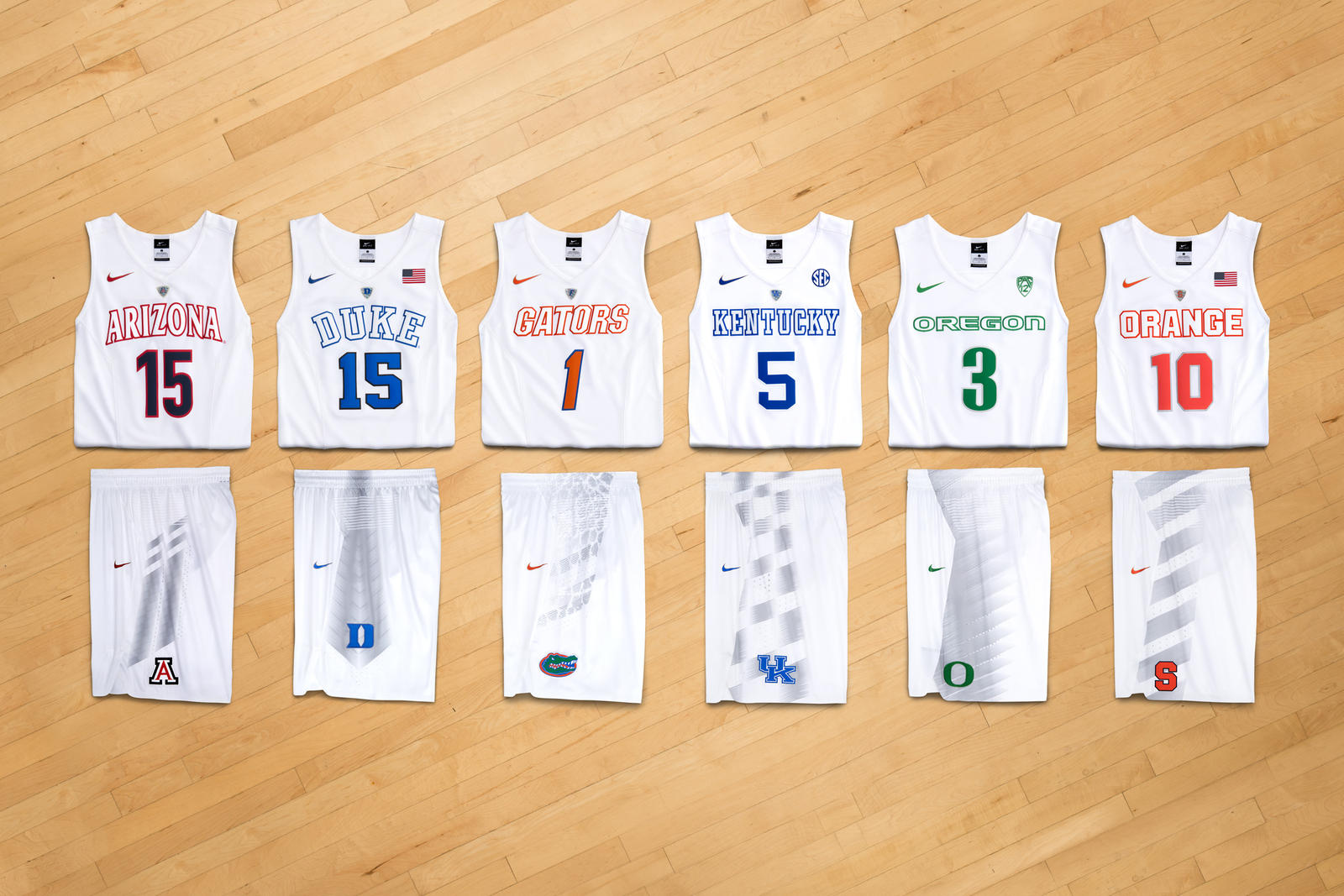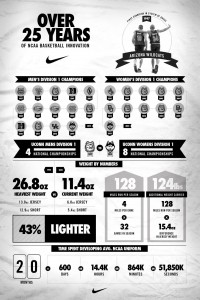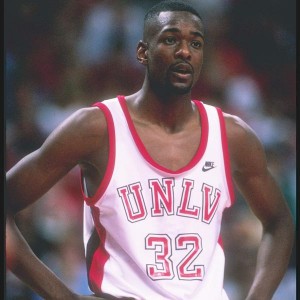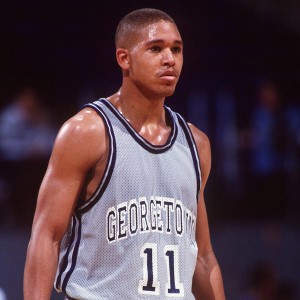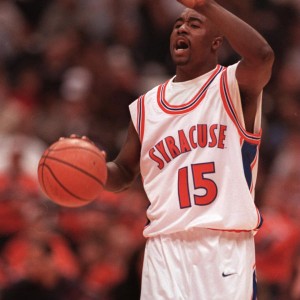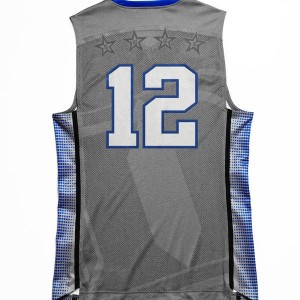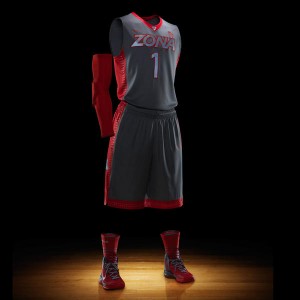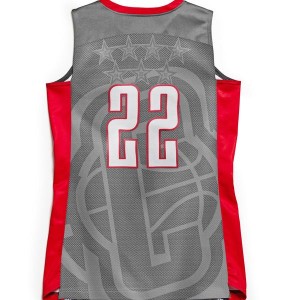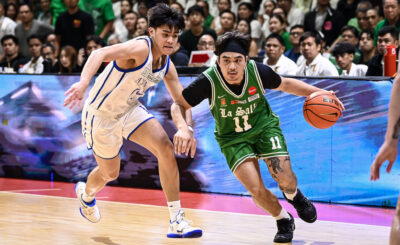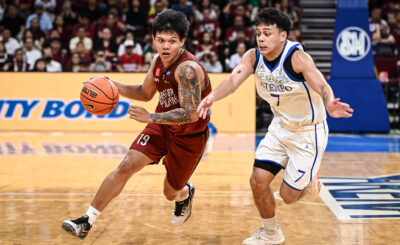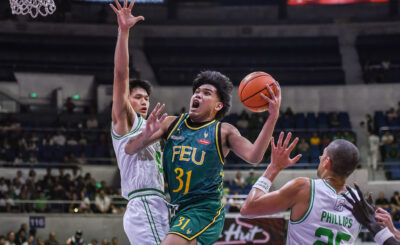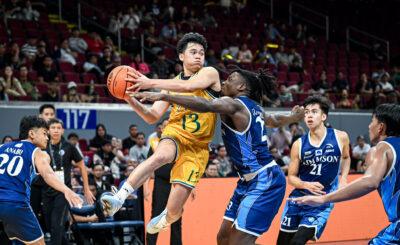INSIDE ACCESS: 25 YEARS OF NCAA UNIFORM INNOVATION
7 March 2015
The road to the college basketball championship has been a fitting showcase for Nike’s Basketball uniform innovation evolution – and revolution – through the years. A legacy that began 25 years ago with three Division 1 college teams continues today with more than 300 of men’s and women’s programs, as the madness of March begins.
Since 1989-1990, Nike Basketball’s aim to set high performance standards on the hardwood has also extended beyond university arenas and field houses. On-court innovation has catalyzed the latest style trends, evolving basketball’s impact in the streets and pop culture. From loose-fitting heathered cotton T-shirts, compression baselayer and shooting sleeves to black socks – now a common sight but once head-turners — collegiate athletes have brought defining looks to the game James Naismith created.
1990: TIME OF THE TRENDSETTERS
Short shorts and heavyweight pro mesh jerseys were the norm when Nike entered college basketball and the calendar flipped to the 1990s. Underlayer options were limited to T-shirts and underwear. Georgetown University’s Twin Towers wore loose-fitting gray or navy blue cotton T-shirts under the jersey, which led to kids across America adopting the T-shirt-under-jersey trend. The Hoyas received Nike’s first full uniform revamp in 1992, debuting a modified jersey and shorts with a more streamlined look. Although relatively subtle, the look established Nike’s intentions to dominate basketball design and establish a new path.
1990S UNIFORMS AND TRENDS
1992: TACKLE TWILL AND SHORTS WITH A SWOOSH
Debuting new design elements, jersey patterns and game-changing fabrications, Nike Basketball expanded rapidly in the mid-1990s. Through bold, confident patterns and one of the nation’s most exciting players, Nike’s jerseys — embellished with tackle twill and expanded pattern inserts — set a fresh standard for game apparel. Shorts challenged tradition by getting looser and longer. The Swoosh logo, now a standard element in uniforms, appeared at the left hip for the first time on game shorts.
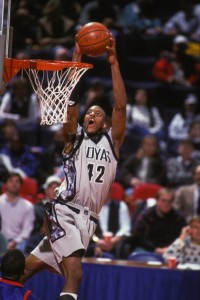 Georgetown 1995
Georgetown 1995
1995: STREET-COURT STYLE ON THE HARDWOOD
Nike supported athlete-led trends as well: Players started cutting sleeves off baselayer T-shirts, and teams bucked convention by moving to baggy shorts and different colored socks. And with that, college hardwood style quickly made its way into the collective culture. Magazines, TV ads and movies gravitated toward American basketball trends that quickly spread internationally.
1995: NEW LAYER LOWERS TEMPS
Fabricated from either nylon dazzle or pro mesh, the early 1990s uniforms weighed nearly a pound (12 oz). In 1995, the Nike basketball uniform took a significant step forward with the introduction of a Dri-FIT underlayer that offered moisture control to wick away sweat from the body. This initial experiment with thermoregulation was critical — Nike’s on-court innovations continue to provide cutting-edge, lightweight solutions for keeping athlete’s comfortable and dry.
1997: ARIZONA’S WINNING LOOK
In 1997, the University of Arizona Wildcats provided a milestone moment: They became the first college basketball team to claim a national championship in full Nike apparel and footwear. In the run to the title, ‘Zona knocked off three No. 1 seeds — an unprecedented feat — and also unveiled the now-iconic, Eric Avar-designed Nike Foamposite 1 shoe.
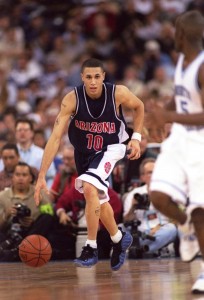 1997 Arizona
1997 Arizona
2001: DRI-FIT MESH AND A NEW NECKLINE
By 2001, Nike had approximately 20 elite Division 1 basketball teams outfited in on-court apparel. As the new millennium got into full swing, these schools — including the University of Arizona and Duke University — benefitted from revolutionary fabrications that dropped uniform weight down to 9.3 ounces. Moving away from standard materials such as dazzle nylon and pro mesh, Nike progressed from Dri-FIT underlayers to similar moisture management in the full uniform itself, incorporating flat-back Dri-FIT mesh iin the jersey and shorts. Shorts remained long and loose, but jersey patterns continued to quickly evolve. Most notably, Nike introduced a new neckline that set the standard for all jersey silhouettes to-follow.
2004: NIKE SPHERE LIGHTENS UP UNIFORMS
Nike Basketball emphasized moisture management and lightweight performance with the introduction of Nike Sphere in 2004. A new neckline modernized the jersey silhouette and helped reduce the uniform weight to a little over 9 ounces.
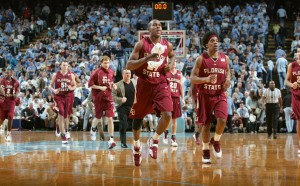 FSU Sphere uniform
FSU Sphere uniform
2007: SYSTEM OF DRESS INTRODUCED
Nike Basketball’s next evolution came in 2007 with the introduction of a new “System of Dress” concept, including a head-to-toe, integrated look. The new uniforms debuted on the reigning national champion University of Florida Gators, the University of Arizona and The Ohio State University and ushered in a noticeable shift in on-court apparel. The tailored jersey matched with longer, loose shorts delivered a sophisticated new look.
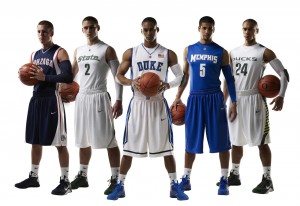 Nike’s System of Dress
Nike’s System of Dress
Nike also provided teams with additional Nike Pro Compression baselayer options — long-sleeve, short-sleeve and sleeveless tops, along with bottoms of varying lengths. These new options allowed players to customize the uniform to their individual needs. As an added touch, baselayer pieces were also decorated with team-specific insignias and graphics honoring past achievements and legacy moments such as the names of hall of fame players, mascots and more.
Lightweight and breathable, the System of Dress uniforms responded to a cultural shift in the game of basketball and improved mobility and thermoregulation on-court.
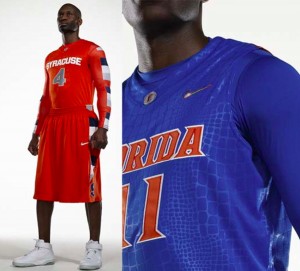 Nike “System of Dress” Cuse and Florida
Nike “System of Dress” Cuse and Florida
2009: PROTECTION FROM THE INSIDE OUT
In 2009-10, the brand introduced the next iteration of the system of dress approach: the lighter Nike Hyper Elite uniform.
Starting from the inside out, the fresh 360-degree look began with innovative Nike Pro Combat padded baselayer. The product technology was directly informed by testing and insights from Kobe Bryant and LeBron James, who both wore the padded compression layer in Beijing to win gold. Reacting to an evolution in the physicality of the game, the basketball-specific protective padding maximized protection without restricting mobility.
Five programs, including Duke University, paired Nike Pro Combat base layers and Nike Aerographic jerseys fabricated with engineered mesh for zoned ventilation and dramatically reduced fabric density. The technology, which reduced jersey weight by 31 percent, also allowed for dynamic, breakthrough graphics. The Blue Devils’ uniform displayed the iconic Duke Chapel, its gothic architecture symbolic of institutional heritage.
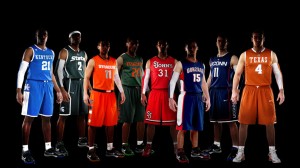 Nike Hyper Elite Team, 2010
Nike Hyper Elite Team, 2010
2011: RECYCLED POLYESTER REDEFINES PERFORMANCE
Nike Hyper Elite uniforms got a refresh in 2011, pushing the boundaries of both performance innovation and sustainable manufacturing. New uniforms introduced by the University of North Carolina and Michigan State University were made of 80 percent recycled polyester. By season’s end, the environmentally-friendly fabrication shaped uniforms for all of Nike Basketball’s 80-deep family of schools.
2012: LIGHTER, LEANER HYPER ELITE
Created specifically for superior performance and lower environmental impact, the Nike Hyper Elite Platinum uniforms launched on nine of the nation’s most storied college programs in 2012.
Five percent lighter than previous uniforms, the Nike Hyper Elite Platinum incorporated shorts built from 100 percent recycled fabric and a jersey of at least 96 percent recycled fabric. The fit, an evolution of 2007’s original System of Dress, incorporated sport-specific tailoring and enhanced efficiency of movement. Laser perforations to the side panels of the shorts increased breathability, while Nike Sphere fabric on the front of the jersey encouraged thermoregulation. Distinct, team-driven designs were made possible though use of full Nike Aerographics back panels — the final piece in a puzzle that solved for performance, style and sustainability.
HYPER ELITE PLATINUM UNIFORM
2013: ROAD TESTED
With the 2013 Hyper Elite Road uniform, the design aimed to provide an advantage away from home. The Nike Hyper Elite Road uniform expanded on the chassis introduced with the Nike Hyper Elite Platinum, and introduced bold home court-inspired graphics at the center chest. The back nameplate featured iconic references to each school’s mascot and home crowd.
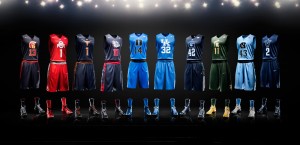 Hyper Elite team shot
Hyper Elite team shot
2014: PERFORMANCE PAST AND PRESENT
Fusing premium apparel innovation with school heritage, 2014’s Nike Hyper Elite Dominance uniforms celebrated the past and present of seven pinnacle programs: Michigan State University, The Ohio State University, Duke University, University of Kentucky, Syracuse University, University of Oregon and University of North Carolina.
The lightweight jersey incorporated Nike Sphere fabric with flocking at the interior neck for sweat management and articulated armholes for maximum range of motion. The shorts, crafted from 100 percent recycled polyester, feature a laser-perforated four-way stretch fabric for ventilation.
All seven uniforms honored each respective program’s winning traditions with special logos, scripts and colors pulled from outstanding seasons past.
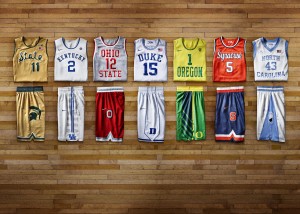 NCAA_Hyper Elite Dominance
NCAA_Hyper Elite Dominance
2015: THE NEXT CHAPTER
Heading into this year’s tournament season, the Nike Hyper Elite uniform evokes school heritage through cutting-edge graphics fused with game-changing thermoregulation. The addition of a flocked “wipe zone” at either hip advances performance value in the Nike Hyper Elite shorts. Athletes are given a new level of cooling while maintaining comfort and security.
Each school’s home uniform will feature a white base with school-specific color lettering and a 26-degree speed graphic of an iconic symbol of each school across the side of the game short. The 26-degree angle of each school’s graphic was inspired by the chevron on the classic Nike Windrunner track jacket that debuted in 1978. Each graphic represents a distinctive basketball point of view, based on the roughly 1,000 directional changes, or “cuts” that a player might make in the course of a game.
The difference in weight between the 1995 uniform (26.8 ounces) and the current 2015 Hyper Elite uniform (11.4 ounces), is 15.4 ounces, or roughly 124 additional pounds carried per college player in in the 1994-95 season.
The pinnacle of performance-led style, the Hyper Elite Disruption uniform represents Nike’s latest industry–leading innovation.
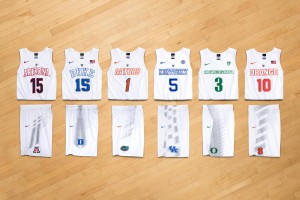 Hyper Elite Men’s team
Hyper Elite Men’s team
CHAMPIONSHIP TRADITIONS
Since the University of Arizona’s title in 1997, 13 of the past 18 men’s national championship teams have worn full head-to-toe Nike uniforms. This includes a run of seven trophies from 2001 to 2007, capped by back-to-back wins for the University of Florida Gators. On the women’s side, eight of the past 14 champions have been dressed in Nike.
The University of Connecticut has claimed 12 combined national championships in Nike uniforms, including nine for coach Geno Auriemma’s Huskies.
From court to culture, Nike Basketball’s focus on uniform innovation has shaped the aesthetic of the sport for decades and will continue to produce new defining moments in years to come.
Follow the writer on Twitter: [social link=”https://twitter.com/burnsports” icon=”62218″]

